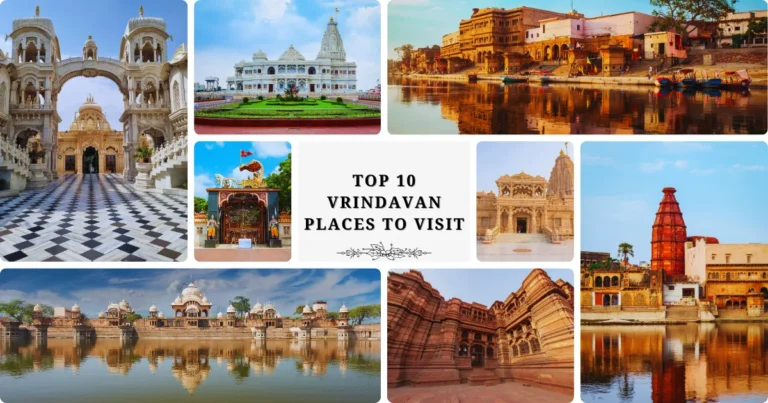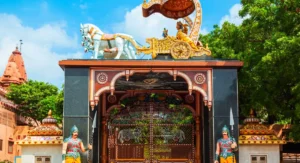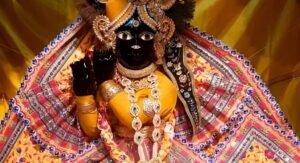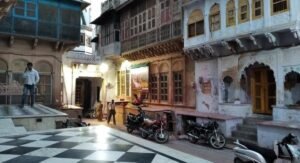Top 10 Vrindavan places to visit is not a tourist list you rush through—it is a series of pauses. Pauses between two bells, between the aroma of sandalwood and the next sip of lassi, between the stories you’ve heard and the ones that meet you in the lanes. Vrindavan is not just about arrival; it’s about letting the town’s rhythm become yours.
This guide—written by mathura vrindavan temples—is not to tick names but to hold moments. Still, names help you begin. Here are the ten that will stay with you long after you’ve left.
Table of Contents
Toggle1. Banke Bihari Mandir — The Pulse You Can Hear
The curtain moves, darshan comes and goes like breath. Built in the 19th century by Swami Haridas, this is where the deity’s gaze feels alive, almost shy. In winter, wait for the fog to soften before you go; in summer, the evening darshan glows softer. Crowds press, but if you stand still, the moment finds you.
Read More about – Banke bihari Mandir
2. Prem Mandir — Marble That Glows at Dusk
White marble in daylight; storytelling in light after sunset. Prem Mandir narrates scenes from Krishna and Rama’s life across its walls. Evenings bring musical fountains and a steady flow of families. It is one of those famous temples in Vrindavan where devotion and design walk hand in hand. Arrive while it’s still light—you’ll see the carvings, then the glow.
Read more about – Prem Mandir
3. ISKCON (Sri Sri Krishna Balaram) — Order in the Chant
Founded in 1975 by Srila Prabhupada, this temple hums with constant kirtan. White marble floors, clear paths, and gentle management make it easy for elders and children. If you need a soft entry into the top tourist attractions in Vrindavan, start here. And if you can, be there for the 4:30 AM mangala aarti—it will set the tone for your day.
Read more about – ISKCON
4. Radha Raman Temple — The Fragrance of Tradition
Compact, quiet, and classical—built in 1542 by Gopala Bhatta Goswami, one of the six Goswamis of Vrindavan. The deity is said to have manifested on its own. Morning shringar is a visual hymn; evening aarti is a whispered poem. Space is small, so arrive early and let the sevā teach you patience.
Read more about – Radha Raman temple
5. Nidhivan — The Grove Where Stories Breathe
A walled grove where no one stays after sunset. Locals say Radha and Krishna’s ras leela continues here at night. The air carries a stillness that asks you to lower your voice. Visit in late morning when sunlight filters through twisted trees, and go with someone who knows the legends—it changes what you see.
Read more about – Nidhivan
6. Seva Kunj — A Garden with Music in It
Known for tales of Krishna serving Radha, Seva Kunj feels like a resting place for the town’s music. In the morning, you might see peacocks; in the afternoon, you hear footsteps on dry leaves. It’s not grand, but it’s one of those corners where Vrindavan slows down for you
7. Rangnath (Rangji) Temple — South Meets North
Built in 1851 in Dravidian style, its gopuram rises like a piece of Tamil Nadu in Braj. The corridors are wide, the stone cool underfoot, and the evening aarti fills the air with echoing chants. Dress modestly—this is a temple that holds its traditions firmly.
8. Radha Damodar Temple — For the Script and the Soul
A place for worship and study, associated with Jiva Goswami. Here, the scent of incense mingles with the rustle of old scriptures. Not as crowded as the larger temples, it gives you the rare gift of sitting still in Vrindavan without being hurried along.
9. Madan Mohan Temple — The Hill That Remembers
One of the oldest in Vrindavan, its red sandstone walls stand a little above the Yamuna. The original deity was moved to Rajasthan centuries ago, but the temple remains a landmark. Go at sunrise for views over the river and the quiet that comes before the town wakes.
Read more about – Madan Mohan Temple
10. Kesi Ghat — Steps into the Story
Named for Krishna’s slaying of the Kesi demon, this ghat is a meeting of water, stone, and sky. Boats wait for short rides; evening aarti sets lamps afloat on the Yamuna. Mornings here are gold for photographers; evenings are gold for the heart.
Read more about – Kesi Ghat
Best time to visit Vrindavan
The best time to visit Vrindavan depends on the kind of day you want:
- October–February: Cool air, fog-soft mornings, warm aarti evenings.
- March–April: Holi’s colors and spring breeze.
- July–September: Monsoon greens, softer crowds.
Festival days are beautiful but busy—arrive early and expect time to stretch. Weekdays in winter or post-monsoon are kindest if you seek calm.
Planning without losing your breath
- Pick 4–5 spots a day, not all ten—leave room for repetition.
- Use e-rickshaws for short temple hops; they know the lanes better than maps do.
- Carry a shawl in winter, water in summer, and a small pouch for prasad.
- Check noticeboards for timing changes—especially in winter.
- Most of all, keep space between two bells; that’s where Vrindavan meets you.
FAQs of the Top 10 Vrindavan Places to Visit
1) Which are the most famous temples in Vrindavan for first-time visitors?
Banke Bihari, Prem Mandir, ISKCON, and Radha Raman are ideal starting points.
2) Can I see all top tourist attractions in Vrindavan in one day?
You can, but you’ll remember them less. Two days, with pauses, will let the town stay with you.
3) What is the best time to visit Vrindavan if I want fewer crowds?
Weekdays in winter or the weeks just before/after major festivals.
4) Are there entry fees for these sites?
Temples are free; some gardens and boat rides may have nominal charges.
5) Can mathura vrindavan temples plan a route for the Top 10 Vrindavan places to visit?
Yes. We create humane itineraries, matching your pace to the town’s heartbeat.




